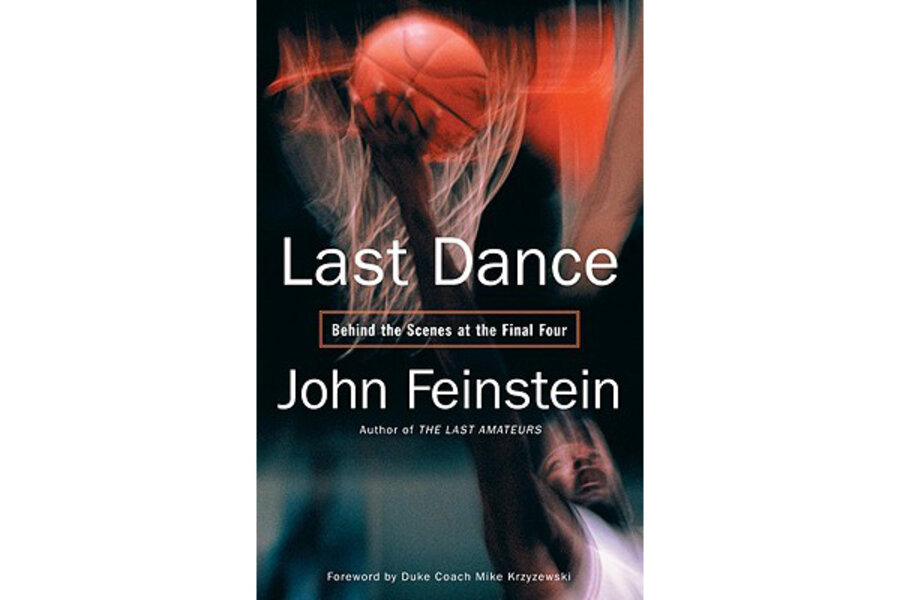Classic review: Last Dance: Behind the Scenes at the Final Four
Loading...
[This review from the Monitor's archives originally ran on March14, 2006.] With the annual March Madness once more upon us, it seems an appropriate time to consider how the once-modest NCAA basketball tournament (which wasn't even televised until 1968), has become second only to the Super Bowl as an annual pageant of electronic athletic excess. (Hint: The $6-billion multi-year TV contract didn't hurt any.)
John Feinstein's Last Dance: Behind the Scenes at the Final Four nicely answers most of the questions that both casual and hard-core fans might have.
The author, a commentator on NPR and contributor to The Washington Post, is a type of bestseller factory, a man who over the past quarter century has become the victim of nearly as much professional envy as that visited upon Duke University coach Mike Krzyzewski. (Appropriately enough, Coach K. wrote the book's introduction.)
But Feinstein's not merely prolific; he's also quite good. His book about then-Indiana Hoosiers Coach Bobby Knight, "A Season on the Brink," was the bestselling sports book of all time, until Feinstein eclipsed his own record with a golf tome, "A Good Walk Spoiled."
Once more, Feinstein manages just the right mix of sentimentality and irreverence, especially when it comes to the NCAA hierarchy.
The stars of this saga are the players, coaches, and even referees who have reached the pinnacle of the Final Four, the tournament's culminating weekend.
There's Dean Smith, the second-winningest coach in history, who nevertheless routinely tries to spin the media into painting his team as the underdog.
There's the late coach Jim Valvano of North Carolina State, given to quoting Carl Sandburg in his recruiting videos, who achieved basketball immortality by racing wildly around the court looking for someone to hug after his team won a championship.
And there's the yin and yang of the sport's TV color men: the cerebral and emotionally reserved Billy Packer and his far more voluble counterpart, ESPN's Dick Vitale.
This is a Feinstein production, so there are plenty of stories to tug at the heart, including the solemn recitation of how players, coaches, and even veteran sportswriters got "tingles" before a big game.
There are also the obligatory stories about memorable moments that have passed into college hoops lore, like the time the late, beloved broadcaster Al McGuire interviewed Georgetown coach John Thompson's storied towel. Mostly, they fit nicely into the tapestry.
Feinstein reserves what little bile he has for the humorless brass of the NCAA, whose handbook actually bans the word "player" in favor of "student-athlete."
They've managed to take the romance out of the tradition of the winning team cutting down the net (an official ramp is now installed for that purpose). And don't even consider using the term "March Madness" without permission: the NCAA has it trademarked.
He nicely brings to life the closed-door wheeling and dealing of the 10-member NCAA committee charged with picking the 64 tournament teams. He raises his eyebrows just a bit at the rampant commercialism, such as the lavish "sneaker suites" at Final Four weekend, sponsored by athletic-shoe companies.
There are plenty of old-timers opining about how the Final Four has gotten too big, how things were just, well, cozier back in the day. But as a skilled oral historian, Feinstein manages to highlight the timelessness of the quest for this brand of athletic excellence.
My favorite story: Immortal UCLA coach John Wooden, now well into his 90s, recounts how he recently visited a Duke practice. His successor as the sport's top coach, the aforementioned Coach K., invites him to sit in, and Wooden comes away impressed.
"I really liked his practice," Coach Wooden tells the author. "No wasted motion or time. A clear plan about what was to be done that day. I remember sitting there thinking, 'The only thing that would be more fun than watching this practice would be to run it.' "
For those of us who can neither run it nor watch it, this book is the next best alternative.
• John Ettorre is a freelance writer in Cleveland, Ohio.






